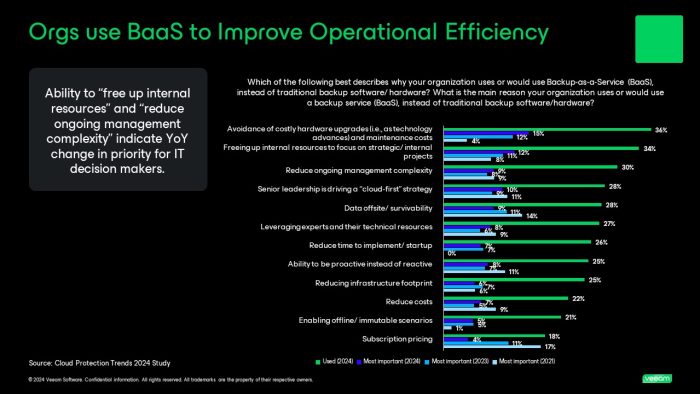
Why BaaS and DRaaS in 2024
The 2024 Data Protection Trends Report revealed that 88% of organizations intend to use Backup as a Service (BaaS) and Disaster Recovery as a Service (DRaaS) for at least some of their servers within the next two years.
“Within the next two years” is a notable caveat, since many organizations are already using BaaS and DRaaS platforms. This industry shift is not a catalytic change that has never been seen before but is simply an extension of the growing general preference to embrace cloud-powered solutions for many IT workloads — including data protection. The growing interest seen year-over-year in BaaS and DRaaS is why the Cloud Protection Trends Report is published in the first place — to dig deeper into those who increasingly show interest in BaaS and DRaaS in the Data Protection Trends Report.
Why BaaS?
As mainstream use of BaaS usage continues to grow, it is paramount that you understand the many considerations and motivations that drive BaaS within organizations of all sizes. Whenever organizations choose to leverage cloud-powered services instead of utilizing infrastructure within their datacenter(s), the question of “why?” is usually answered with business goals and/or functional enablement.
When organizations were asked why they use BaaS instead of traditional on-premises hardware/software, their primary reasons all point to operational efficiency, like reducing hardware upgrades, internal resources, and/or manageability.
Why DRaaS?
While employing BaaS is like setting out mouse traps, implementing DRaaS is more akin to having an expert come out to assess how the mice are coming in and deploying the right kinds of traps that fit your house. DRaaS ensures that your outcomes are not just limited to your previous experiences, but instead unlock the expertise of DRaaS-specific experts to partner with you.
When organizations were asked why they use DRaaS instead of secondary data centers, their primary reasons surrounded expertise, including utilizing the expertise of third-party subject matter experts for implementation. Other reasons included planning and reducing the demands of internal experts and wanting to leverage their IT employees for more strategic purposes.
What does BaaS mean to you?
One of the most intriguing questions the Cloud Protection Trends Report asked of IT leaders was: “What does BaaS mean to you?”
When looking at the most common and most “foundational” considerations continue to be:
- The backup engine runs as a cloud service instead of an on-premises executable
- The solution is managed via a web-based UI
- The data resides in a cloud repository outside of your production environment
It is notable that, like many other early cloud-based services, the initial justifications and presumptions have all waned as adoption into the mainstream has continued (e.g., reducing on-site hardware or subscription pricing). That said, the most significant market change over the last four years has been the customer expectation that backup services should be provided by the same vendor who produced the actual backup software itself.
When asked what the single most important aspect of BaaS was, respondents said that it should be “delivered by the first-party software vendor.” This desire to receive BaaS from the same organization who makes the software itself has risen as an area of interest. In response to this customer demand, enter Veeam Data Cloud.
The new Veeam Data Cloud is built on Microsoft Azure and delivers the confidence and reliability of an industry-leading platform with the ease and accessibility of a cloud service. Today, Veeam Data Cloud provides BaaS for Microsoft 365 and Microsoft Azure, enabling radical resilience and leveraging powerful data protection and security technology within a simple, seamless user experience.
Which BaaS or DRaaS solution is right for you?
There is not a single “best” choice because what will protect your organization the most effectively will vary based on the skills that your teams have vs. what you need to supplement either operationally or in scenario expertise. It also depends on where your data is located — within your datacenters, across your remote offices, and throughout public clouds that offer infrastructure (IaaS), platforms (PaaS), or full software stacks (SaaS) like Microsoft 365 or Salesforce. It also depends on which skills your teams have, and their intent moving forward to manage/utilize, compared to what you are looking for in your service providers’ teams of experts and offerings. Luckily, Veeam has 13,000+ Veeam Cloud & Service Provider (VCSP) partners that offer BaaS and DRaaS solutions powered by Veeam. Organizations can engage Veeam partners for a managed offering to protect their data, including Microsoft 365, public cloud, DRaaS and more. A staple of modern data protection is having a service that works best for your needs — no ifs, ands, or buts. To help, here are two livestreams (available on-demand) to fuel your considerations:
We hope this helps in your conversations within your teams and with your partners. So, check out the livestreams and download the 2024 Cloud Protection Trends Report! If you have other questions about this research, reach out to StrategicResearch@veeam.com.



You must be logged in to post a comment.